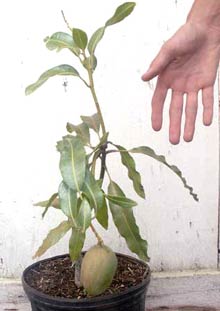Method of propagating mango by seed
There are many mango trees that grow from seeds without degenerating, but the quality of mangoes is still guaranteed. Many of our mango varieties in seeds have many embryos - called multi-embryos.
All embryos grow into plants. Most of those embryos are asexual embryos formed by embryonic cells. The plants formed from asexual embryos retain the characteristics of the mother plant, as well as the extracting plants, grafting or cuttings. Only one plant develops from embryos that are sexual due to pollination and fertilization. This tree is easy to identify because it is often a bad tree, stunted, to remove.
 How to propagate mangoes with plants grown from asexual embryos is still preferred by many countries. Because it not only does not lose the good properties of the mother tree, but also ensures the uniformity of the seedlings and especially the plants live for a long time. In Punjab State (India) with mango trees living for thousands of years, its perimeter is nearly 13 m long, the coverage of the canopy accounts for 3,000 m2 .
How to propagate mangoes with plants grown from asexual embryos is still preferred by many countries. Because it not only does not lose the good properties of the mother tree, but also ensures the uniformity of the seedlings and especially the plants live for a long time. In Punjab State (India) with mango trees living for thousands of years, its perimeter is nearly 13 m long, the coverage of the canopy accounts for 3,000 m2 .
Mangoes can be grafted onto trees with the same family as toad (also known as the west crocodile), and the cashew tree (also known as trench - Anacardium xcidenta L). For large fruits, small seeds, delicious fruit, but small plants, poor life expectancy. In many countries, even in our country, people still use muddy, crumpled or twisted trees called calluses to make rootstocks. The phenomenon of non-synaptic graft can also occur in some places. It is thought to be due to the effects of weather or land.
Be careful you can try it before mass transplant. It is better to use the seeds of the mango varieties to sow the rootstock. Choose a healthy growth variety and have been planted for many years in your locality, so you don't have to worry.
Mango grafting gives good results, high survival rates, depending on the skill or familiarity of each person with each way. In our opinion, the simplest way of grafting is wedges on young rootstocks. In this way, first take a very new seed from the mango fruit, wash it, then sow immediately. When the seedlings grow, take out the seedlings to plant on a well-made bed, apply fertilizer at a density of 35-40 cm or plant in pots or potting bags with good soil mixed with manure, then take care of normal growing plants. . When plants 40-50 cm tall, the leaves have changed from purple to green, the stem is 0.5 cm wide and can be grafted.
Grafted cuttings from branches with the same diameter as the grafted tree root of less than 1 year old, grow at the ends of the branches, need cuttings 10-12 cm long, remove all the leaves, and put them into the clean wet cloth wrap Put the foot in the water jar. Take enough for 1-2 hours for the cuttings to dry out. When paired, beveled 2 sides of the cuttings with a thickness of about 1 cm. In the rootstock tree, also cut the tops above the position of the real leaves first, then split along the middle to add about 1 cm. Seasoning into grafted root, tightly wrapped plastic tape. Then, use one-sided sealed plastic bags to cover all the stems and graft marks, making the sunshades rain. When transplanting buds, remove the plastic bags for growing buds. Shoots up into 75-80cm tall trees. Green leaves turn into green.
The transplanting and planting of mangoes should be avoided during the hot sun or cold, rainy.

(Photo: Unv.org)
- The plastic layer in the mango shell is just a natural silk shell
- The best mango seed market in the world
- Should you eat ripe mango or green mango?
- Breeding old banana dwarf by tissue culture method
- Australia tested the world's first mango picking robot
- Interesting benefits of mango fruit
- Can chocolate be made from mango fruit?
- Surprise with the health benefits of mango leaves
- An Australian farmer developed a mango-flavored coconut variety
- Eating mangoes can fight cancer
- 11 reasons to increase mango consumption
- Mango trees break the plan for 800 fruits in Japan
 Why do potatoes have eyes?
Why do potatoes have eyes? 'Tragedy' the world's largest carnivorous life: Death becomes ... public toilet
'Tragedy' the world's largest carnivorous life: Death becomes ... public toilet Tomatoes were once considered 'poisonous' for 200 years
Tomatoes were once considered 'poisonous' for 200 years Detecting microscopic parasites on human face
Detecting microscopic parasites on human face